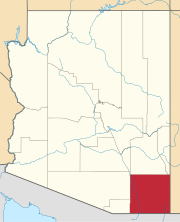Tombstone, Arizona: Difference between revisions
Nick Number (talk | contribs) m →Television: fixed shadow person wikilink |
|||
| Line 223: | Line 223: | ||
* [http://www.cityoftombstone.com City website] |
* [http://www.cityoftombstone.com City website] |
||
* [http://www.tombstonechamber.com/ Tombstone Chamber of Commerce] |
* [http://www.tombstonechamber.com/ Tombstone Chamber of Commerce] |
||
* [http://tps.cr.nps.gov/nhl/detail.cfm?ResourceId=88&ResourceType=District Tombstone Historic District] from a [[National Park Service]] website |
|||
* [http://www.tombstoneweb.com/ Tombstone directory] |
|||
* [http://www.tombstonetimes.com/ Tombstone history] |
* [http://www.tombstonetimes.com/ Tombstone history] |
||
* [http://www.loc.gov/exhibits/treasures/trr016.html 1886 fire insurance map of Tombstone] |
|||
* [http://memory.loc.gov/cgi-bin/query/S?ammem/pan:@field(SUBJ+@od1(Arizona--Tombstone+)) 1909 Panoramic photograph of Tombstone] |
* [http://memory.loc.gov/cgi-bin/query/S?ammem/pan:@field(SUBJ+@od1(Arizona--Tombstone+)) 1909 Panoramic photograph of Tombstone] |
||
* [http://memory.loc.gov/cgi-bin/query/r?ammem/fsaall:@FILREQ(@field(SUBJ+@band(Arizona--Cochise+County--Tombstone+))+@FIELD(COLLID+fsa)) Black-and-white photographs of Tombstone taken between 1935-1945] |
* [http://memory.loc.gov/cgi-bin/query/r?ammem/fsaall:@FILREQ(@field(SUBJ+@band(Arizona--Cochise+County--Tombstone+))+@FIELD(COLLID+fsa)) Black-and-white photographs of Tombstone taken between 1935-1945] |
||
Revision as of 21:41, 31 August 2010
This article may need to be rewritten to comply with Wikipedia's quality standards. (July 2010) |
City of Tombstone, Arizona | |
|---|---|
| Motto: The Town Too Tough To Die | |
 Location in Cochise County and the state of Arizona | |
| Country | United States |
| State | Arizona |
| County | Cochise |
| Founded | 1879 |
| Government | |
| • Mayor | Dustin Escapule |
| Area | |
| • Total | 4.3 sq mi (11.1 km2) |
| • Land | 4.3 sq mi (11.1 km2) |
| • Water | 0.0 sq mi (0.0 km2) |
| Elevation | 4,541 ft (1,384 m) |
| Population | |
| • Total | 1,562 |
| • Density | 364.9/sq mi (141.4/km2) |
| Time zone | UTC-7 (MST (no DST)) |
| ZIP code | 85638 |
| Area code | 520 |
| FIPS code | 04-74400 |
| Website | http://www.cityoftombstone.com/ |
Tombstone is a city in Cochise County, Arizona, United States, founded in 1879 by Ed Schieffelin in what was then the Arizona Territory. Formerly a silver-mining boomtown and county seat, the town is most famous as the former home of a number of western gunfighters, and as the site of the Gunfight at the O.K. Corral. Its economy today is based on tourism. According to 2006 Census Bureau estimates, the population of the city was 1,569.[1]
History
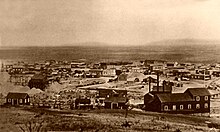
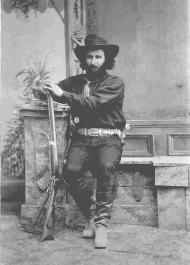
Founding
In the summer of 1877 prospector Ed Schieffelin was working the hills east of the San Pedro River in the southeast portion of the Arizona Territory, when he came across a vein of very rich silver ore in a high plateau called Goose Flats. When Schieffelin filed his mining claim he named it "The Tombstone", after a warning given him by a passing soldier. While telling the soldier about his rock collecting experiences, the soldier told him that the only rock he was likely to collect among the waterless hills and warring Apaches of the area would be his own tombstone.
The town of Tombstone was founded in 1879, taking its name from the mining claim, and soon became a boomtown. Fueled by mineral wealth, Tombstone was a city of 1000 by the beginning of 1881, and within another year Tombstone had become the seat of a new county (Cochise County) with a population between 5,000 and 15,000, and services including refrigeration (with ice cream and later even ice skating), running water, telegraph and limited telephone service, and a newspaper aptly named the Tombstone Epitaph.[3] Capitalists and businessmen moved in from the eastern U.S. Mining was carried out by immigrants from Europe, chiefly Ireland and Germany. An extensive service industry (laundry, construction, restaurants, hotels, etc.) was provided by mainly Chinese, and few other immigrants.
Wealth
Precise figures of the value of the gold and silver which was mined in Tombstone are difficult to come by. In 1883, writer Patrick Hamilton estimated that the total value of gold and silver taken from Tombstone during the first four years of activity was $25,000,000. In 1902, W. P. Blake came up with figures which are believed to be much more accurate at $3,000,000. As a consequence of the vast amount of riches which were being distributed, lawsuits started to become very prevalent. Between 1880 and 1885 courts were clogged with activity, with most cases having to do with valuable properties. As a result, lawyers began to settle in Tombstone and became even wealthier than the miners and those who financed the mining expeditions. In addition, because many of the lawsuits required expert analysis of the underground, many geologists and engineers found employment in Tombstone and settled there. In the end, a thorough mapping of the area was completed by these experts, one which was considered to be better than any other mining district of the West.[4]
The city of Tombstone was quite wealthy and much money was spent during its boom times. Growing in sophistication, Tombstone’s first newspaper, the Nugget was established in the fall of 1879. The Tombstone Epitaph which is considered unique because of it being the only one of its name in the world was founded on May 1, 1880. As a consequence of an increase in population, saloons brought in wealth and a variety of stores began to emerge. Visitors expressed their amazement at the quality and diversity of products which were becoming readily available in the area. In addition, citizens of Tombstone dressed well and fashion was not out of touch in this growing mining town.[5]

Without railroad access the increasingly sophisticated Tombstone was relatively isolated, deep in a Federal territory that was largely unpopulated desert and wilderness. Tombstone and its surrounding countryside also became known as one of the deadliest regions in the West. Southern gangs from the surrounding countryside, known as "cow-boys", were at odds with the northern capitalists and immigrant miners who ran the city and mines. The city council of Tombstone at one point created laws preventing its own citizens from going about the town while armed. These laws were not in force outside the town, as Apaches held the most of the countryside and small arms were needed for protection. The situation required people arriving in town or leaving it to deposit or pick up their firearms. On October 26, 1881 this situation famously exploded in the Gunfight at the O.K. Corral, leading to a continued family and political feud that resulted in multiple deaths. The Earp Vendetta Ride resulted from the O.K. Corral gunfight and eventually led to Wyatt Earp's retreat from the territory to Colorado.
On December 25, 1881 the Bird Cage Theater opened, and in 1882 the New York Times reported that "the Bird Cage Theatre is the wildest, wickedest night spot between Basin Street and the Barbary Coast."[6]
Decline as a boomtown
Since Tombstone was in the desert, a company built a pipeline to supply the town with water. No sooner was this pipeline built than Tombstone's silver mines struck water.
As a result of relative lack of water and quick wooden construction, Tombstone experienced major fires in June 1881 and May 1882. The second fire was particularly destructive and signaled the end of the classic old boomtown mining city. After the mid-1880s, when the silver mines had been tapped out, the main pump failed, causing many mines to be flooded with deep groundwater, and Tombstone declined rapidly. The U.S. census found it had fewer than 1900 residents in 1890, and fewer than 700 residents in 1900.
Tourism
The 1900 census was a minimum, however, and Tombstone was saved from becoming a ghost town after the decline of silver mining, partly by its status as the Cochise County seat. Even the county seat was later moved by popular vote to nearby Bisbee in 1929. However, the classic Cochise County Courthouse and adjacent gallows yard in Tombstone is preserved as a museum.
Tombstone is home to perhaps the most famous graveyard of the Old West, Boot Hill. Buried at the site are various victims of violence and disease in Tombstone's early years, including those from the O.K. Corral. Boot Hill (also known as the old city cemetery) was also the destination for bad-men and those lynched or legally hanged in Tombstone. Admission to this historic site is free and donations are accepted.
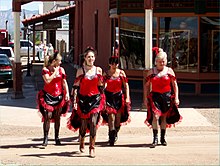
The lot in which the historic gunfight at the O.K. Corral occurred in 1881 is also preserved, but this has been walled off, and admission is charged. However, since much of this street fight occurred in Tombstone's Fremont Street (modern Highway 80), much of this site is also viewable without admission charge.
According to Guinness, the world's largest rosebush was planted in Tombstone in 1885 and still flourishes today in the city's sunny climate. This Lady Banksia rose now covers 8,000 sq ft (740 m2) of the roof on an inn, and has a 12 ft (3.7 m) circumference trunk. The rose bush is also walled off, and admission is charged.[7]
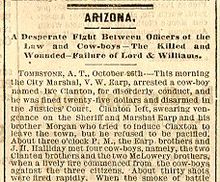
Currently, tourism and western memorabilia are the main commercial enterprises; a July 2005 CNN article notes that Tombstone receives approximately 450,000 tourist visitors each year. This is about 300 tourists/year for each permanent resident. In contrast to its heyday, when it featured saloons open 24 hours and numerous houses of prostitution, Tombstone is now a staid community with few businesses open late.
Performance events help preserve the town's wild-west image and expose it to new visitors. Helldorado Days is Tombstone's oldest festival,[citation needed] and celebrates the community's wild days of the 1880s. Started in 1929 (coincidentally the year Wyatt Earp died), the festival is held on the third weekend of every October (loosely corresponding to the date of the O.K. Corral gunfight) and consists of gunfight reenactment shows, street entertainment, fashion shows and a family-oriented carnival. Meanwhile, Tombstone's Main Event: A Tragedy At The OK Corral (2007), a stage play by Stephen Keith, presents the cowboys' perspective of the events leading up to the shootout and is presented inside the actual OK Corral.
Historic district


The Tombstone Historic District is a National Historic Landmark District. The town's focus on tourism has threatened the town's designation as a National Historic Landmark District, a designation it earned in 1961 as "one of the best preserved specimens of the rugged frontier town of the 1870s and '80s." In 2004, the National Park Service (NPS) declared the designation threatened, seeking to work with the community to develop an appropriate stewardship program. The inappropriate alterations to the district cited by the NPS include:
- Placing "historic" dates on new buildings
- Failing to distinguish new construction from historic structures
- Covering authentic historic elevations with inappropriate materials
- Replacing historic features instead of repairing them
- Replacing missing historic features with conjectural and unsubstantiated materials
- Building incompatible additions to existing historic structures and new incompatible buildings within the historic district
- Using illuminated signage, including blinking lights surrounding historic signs
- Installing hitching rails and Spanish tile-covered store porches when such architectural features never existed within Tombstone
Geography
Tombstone is located at 31°42′57″N 110°3′53″W / 31.71583°N 110.06472°WInvalid arguments have been passed to the {{#coordinates:}} function (31.715940, -110.064827).Template:GR
According to the United States Census Bureau, the city has a total area of 4.3 square miles (11.1 km²), all land.
| Climate data for Tombstone | |||||||||||||
|---|---|---|---|---|---|---|---|---|---|---|---|---|---|
| Month | Jan | Feb | Mar | Apr | May | Jun | Jul | Aug | Sep | Oct | Nov | Dec | Year |
| Mean daily maximum °F (°C) | 60 (16) |
65 (18) |
69 (21) |
77 (25) |
85 (29) |
94 (34) |
93 (34) |
90 (32) |
88 (31) |
80 (27) |
69 (21) |
60 (16) |
77 (25) |
| Mean daily minimum °F (°C) | 34 (1) |
37 (3) |
40 (4) |
46 (8) |
54 (12) |
62 (17) |
66 (19) |
64 (18) |
60 (16) |
52 (11) |
42 (6) |
36 (2) |
50 (10) |
| Average precipitation inches (mm) | 0.8 (20) |
0.9 (23) |
0.6 (15) |
0.3 (7.6) |
0.2 (5.1) |
0.5 (13) |
3.4 (86) |
3.3 (84) |
1.5 (38) |
0.8 (20) |
0.6 (15) |
1 (25) |
13.9 (350) |
| [citation needed] | |||||||||||||
Demographics
| Census | Pop. | Note | %± |
|---|---|---|---|
| 1880 | 3,423 | — | |
| 1890 | 1,875 | −45.2% | |
| 1900 | 646 | −65.5% | |
| 1910 | 1,582 | 144.9% | |
| 1920 | 1,178 | −25.5% | |
| 1930 | 849 | −27.9% | |
| 1940 | 822 | −3.2% | |
| 1950 | 910 | 10.7% | |
| 1960 | 1,283 | 41.0% | |
| 1970 | 1,241 | −3.3% | |
| 1980 | 1,632 | 31.5% | |
| 1990 | 1,220 | −25.2% | |
| 2000 | 1,504 | 23.3% | |
| 2007 (est.) | 1,562 | ||
| source:[8][9] | |||
As of the censusTemplate:GR of 2000, there were 1,504 people, 694 households, and 419 families residing in the city. The population density was 349.8 per square mile (135.0/km²). There were 839 housing units at an average density of 195.1 per square mile (75.3/km²). The racial makeup of the city was 87.37% White, 0.60% Black or African American, 1.00% Native American, 0.33% Asian, 8.18% from other races, and 2.53% from two or more races. 24.14% of the population were Hispanic or Latino of any race.
There were 694 households out of which 20.2% had children under the age of 18 living with them, 47.6% were married couples living together, 7.9% had a female householder with no husband present, and 39.5% were non-families. 32.9% of all households were made up of individuals and 15.3% had someone living alone who was 65 years of age or older. The average household size was 2.17 and the average family size was 2.73.
In the city the population was spread out with 19.3% under the age of 18, 4.9% from 18 to 24, 19.9% from 25 to 44, 32.5% from 45 to 64, and 23.3% who were 65 years of age or older. The median age was 49 years. For every 100 females there were 94.3 males. For every 100 females age 18 and over, there were 91.0 males.
The median income for a household in the city was $26,571, and the median income for a family was $33,750. Males had a median income of $26,923 versus $18,846 for females. The per capita income for the city was $15,447. About 13.0% of families and 17.4% of the population were below the poverty line, including 22.6% of those under age 18 and 13.1% of those age 65 or over.
Tombstone's representation in media
Tombstone's unique heritage has made the town a popular reference point in television, film, and music, portraying open conflict (between, in this case, rural farmers involved in the cattle-trade, and businessmen who were managing local silver mines).
Film
Tombstone has lent its name to many Western movies over the years, including but not limited to Sheriff of Tombstone (1941), Bad Men of Tombstone (1949), Toughest Gun in Tombstone (1958), Five Guns to Tombstone (1960), and Tombstone (1993). It has also been featured in other films; most notably of which (aside from the aforementioned Tombstone) is the biographical Wyatt Earp (1994).
Music
The Brazilian countrycore quartet Matanza have a song named Tombstone City. Bob Dylan has a song named Tombstone Blues, it appears on the album Highway 61 Revisited. Singer/songwriter Carl Perkins wrote a song titled "The Ballad Of Boot Hill", which focused on Billy Clanton's role in the Gunfight at the O.K. Corral. It was recorded by Johnny Cash for his 1965 Columbia Records album Sings the Ballads of the True West. The first line of the Mason Proffit song "Two Hangmen" has the narrator of the song "riding into Tombstone."
Television
- From 1957 to 1960, Tombstone was featured in the ABC and later syndicated Western television series Tombstone Territory starring Pat Conway as Sheriff Clay Hollister and Richard Eastham as Harris Claibourne, editor of The Tombstone Epitaph newspaper.
- On October 11, 2006, Tombstone was featured in episode #301 of Syfy series Ghost Hunters. The TAPS crew led by Jason Hawes and Grant Wilson visit the Birdcage Theatre, which was a popular night spot frequently visited by legends such as Doc Holliday and Wyatt Earp. TAPS tries to determine if the place is haunted by spirits of old patrons of the Old West.
- On July 3, 2009, the Birdcage Theatre was once again investigated for paranormal activity by the Travel Channel series Ghost Adventures crew. Ghost hunters Zak Bagans, Nick Groff, and Aaron Goodwin investigate the building while being locked in overnight to find any evidence of its reported ghostly occupants.
- On October 13, 2009, Discovery Channel aired an Tombstone episode of Ghost Lab in which Everyday Paranormal investigated the Birdcage Theater, the Crystal Palace, and Boothill cemetery, as well as looked in a silver mine for a possible source of energy to fuel the large amount of paranormal activity in the city. In the Boothill cemetery, they captured a picture of an alleged "shadow person".
Education
Tombstone Unified School District serves Tombstone. The district schools in Tombstone are Walter J. Meyer Elementary School and Tombstone High School.[10][10][11] Residents of the Tombstone school district are within the Cochise Technology District.[12]
References
- ^ a b "Annual Estimates of the Population for All Incorporated Places in Arizona" (CSV). 2005 Population Estimates. U.S. Census Bureau, Population Division. June 21, 2006. Retrieved November 15, 2006.
- ^ "Annual Estimates of the Population for Incorporated Places in Arizona". United States Census Bureau. 2008-07-10. Retrieved 2008-07-14.
- ^ "The History of The Tombstone Epitaph Newspaper". TheTombstoneEpitaph.com. Retrieved 2010-03-15.
- ^ Faulk, O. B., (1972) Tombstone. Oxford University Press: New York, pp. 70.
- ^ Burns, W. N., (1951) Tombstone. Doubleday & Company Inc.: New York, pp. 33-34.
- ^ This Month in History, p. 10, Arizona Highways, December 2008.
- ^ [1][dead link]
- ^ Moffatt, Riley. Population History of Western U.S. Cities & Towns, 1850-1990. Lanham: Scarecrow, 1996, 16.
- ^ "Subcounty population estimates: Arizona 2000-2007" (CSV). United States Census Bureau, Population Division. 2009-03-18. Retrieved 2009-04-25.
- ^ a b "Home." Walter J. Meyer Elementary School. Retrieved on July 28, 2010.
- ^ "Home." Tombstone High School. Retrieved on July 28, 2010.
- ^ "Governing Board." Cochise Technology District. Retrieved on July 28, 2010.


